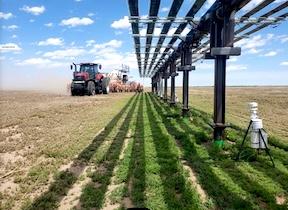
When Tibor Hegedus saw snowdrift fences while on a family vacation, he envisioned an ideal rack for solar panels. He calls the concept a Dynamic Agrivoltaic Shelterbelt. For 18 mos., starting in 2021, he had a test site in place alongside I-80 in Wyoming. For the past year, the 100-ft. long set of 5-ft. long solar panels has been in place on Roy Pfaltzgraff’s northeastern Colorado farm.
“We have 7-in. wide horizontal panels with 7-in. spacing between them,” says Hegedus. “The intelligent control system tracks the sun at lower wind speeds, but moves into a vertical position when the wind gets to a pre-set speed. We have Roy’s set at less than 15 mph wind speed. At that point, it acts as a windbreak with 45% porosity. It also captures blowing snow and creates its own microclimate downwind.”
The panel rack is 12 ft. tall when vertical. At sunrise, it faces east in a vertical or near-vertical position. Through the course of the day, the entire rack rotates to a horizontal plane at midday and faces west in a near-vertical plane at sunset. Hegedus projects that the 100-ft. of panels will produce about 11,000 kW of electricity per year. He estimates the cost in commercial production at around $20,000.
The panels are designed to handle 120 mph winds. Hegedus has placed weather stations and soil moisture sensors downwind from the panels to evaluate the microclimate they create. The impact on crops shielded from high winds has been significant, suggests Pfaltzgraff.
“We have the weather stations and soil monitors at 40, 80 and 120 ft. downwind as well as 40 ft. upwind,” he says. “The first year I saw the data collected, I couldn’t believe it. At 120 ft., the crop used 30% less water, and at 40 ft., it used 50% less water. In our low rainfall area, that’s like moving the farm 150 miles east.”
Pfaltzgraff reports the panels stood up to 90 mph winds twice in the first year and sustained 60 mph winds for three days.
“At low wind speeds, we saw a 25% wind speed reduction at 120 ft. out,” reports Pfaltzgraff. “At higher windspeeds, the reduction was 25 to 30%.”
Unfortunately, the panels couldn’t prevent a hailstorm from wiping out the millet crop planted in the field. While Pfaltzgraff captured no yield numbers, the plants that did survive tested 17% higher in micronutrients than unsheltered plants.
“This year I planted the field to camelina,” says Pfaltzgraff. “I expect it to test out higher in oil content.”
Hegedus is considering expanding the site at Pfaltzgraff’s farm. Pfaltzgraff is frustrated that his power company won’t buy the electricity from him. The two are looking at alternatives.
“We’re considering offering the electricity to a remote data processing center,” says Hegedus. “We’re also looking at integrating the power with other farm needs.”
Whatever happens, Pfaltzgraff is sold on the concept.
“My dream would be to have a solar shelterbelt every 240 ft. across the field,” he says. “I estimate they would take up about two acres of farmable ground out of every 160 acres. It would be well worth it.”
Contact: FARM SHOW Followup, Longboard Power, Colorado Springs, Colo. (ph 719-232-0531; info@longboardpower.com; www.longboardpower.com) or Pfaltzgraff Farms, 12189 County Road 7, Haxtun, Colo. 80731 (ph 970-466-1887; roy@pfzfarms.com; www.pfzfarms.com).
